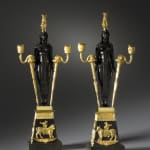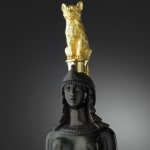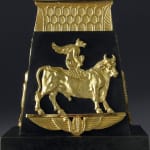Pierre-Philippe Thomire (attributed to) French, 1731-1843
Further images
Literature
Hans Ottomeyer and Peter Pröschel, "Vergoldete Bronzen", 1986, p. 336, pl. 5.3.4, illustrating a design in the Musée du Louvre, Paris by Charles Percier, circa 1800 for a very similar Egyptian caryatid support for a console. And p. 336, pl. 5.3.3, illustrating a similar candelabrum by Pierre-Philippe Thomire with the same figure but with candle branches upon her head and lacking the fasces.
A magnificent pair of Empire gilt and patinated bronze two-light candelabra retour d'Egypte attributed to Pierre-Philippe Thomire after a design by Charles Percier, each surmounted by a gilt cat seated upon the head of a patinated bronze Egyptian female figure wearing a falcon head-dress over a wig of ringlets, a wesekh collar, her sheath gown secured below her breasts by a girdle from which suspends a long thin panel chased with pseudo hieroglyphs, holding in each hand a gilt fasces issuing a serpent holding in its open mouth a single vase-shaped nozzle chased with alternate anthemion and stars, the bare-footed figure standing on a gilt and patinated spreading rectangular plinth chased at the front with a dog-headed monster squatting on a bull and at the sides with pairs of kneeling Egyptian figures surmounted by a cat, on a rectangular base
Paris, date circa 1810
Height 67 cm. each.
The preeminent bronzier Pierre-Phillip Thomire (1751-1843) and his firm produced a number of related Egyptian style candelabra of differing sizes and details to the candle branches. As here, some examples showed the figures holding fasces in each hand, while in other instances they hold palm frond and lotus leaf and support on their heads tiers of candle branches. Judging from the quality of the casting and chasing the present figures date from circa 1810, when Thomire was at the height of his career. These striking candelabra are based on a design by Charles Percier (1764-1838).
Similar figures appear in a pen and ink and watercolour sketch by Percier of circa 1800 as a support for a console table in the Egyptian taste and also feature in his "Recueil de Décorations Intérieurs", 1801, pl. XXXII. In 1806 Thomire delivered a console table featuring similar Egyptian caryatids based on Percier's design to the residence of Consul Charles-François Lebrun (now in the Grand Trianon, Versailles). Then in 1812 Thomire and his associate Duterme delivered another console table with identical bronze caryatid supports to the Garde-Meuble, which is also now in the Grand Trianon, (Denise Ledoux-Lebard, "Inventaire Général du Musée National de Versailles et des Trianons", vol. I, "Le Grand Trianon, Meubles et Objets d'Art", pp. 20-21).
It is likely however that the model for the present candelabra date slightly earlier, examples of which were made by Pierre-Philippe Thomire for the Parisian marchand-mercier Martin-Eloi Lignereux (d. 1809) of rue Taitbout, whose business was purchased by Thomire in 1804 though he did not however own the copyright for these particular figures for another two years. A comparable pair of candelabra by Thomire, with similar supporting figures but with two surmounting tiers of branches and without candle branches in each hand, were supplied in the late 1790's to Czar Paul I for Pavlovsk Palace, Saint-Petersburg, while another pair from the H. de Givenchy collection was sold in Monaco 1993. King Louis-Philippe of France also owned a similar pair at Château de Saint-Cloud, which he then took Château de Compiègne and are now in the Grande Chancellerie de la Légion d'Honneur, Paris.
Unlike the aforementioned examples these Egyptian figures hold in each hand a fasces candle branch in place of a palm frond and lotus leaf. In this they are almost identical to three other known examples. One pair was owned by Prince Anatole Demidoff (1813-70) and was included in the sale of his great art collection at Villa Demidoff de San Donato, Florence in March 1880. Another almost identical pair was previously owned by Edward Medlicott Esq, Sacombe Park near Ware in Hertfordshire and a third pair was once in the Freitherrn von Heylisches, Schloss Hernnschein collection.
Charles Percier's design for this particular caryatid Egyptian female was evidently so popular that it was realised in media other than bronze. For instance almost identical figures were made as gilt painted biscuit figures by the Paris Porcelain Manufactures, possibly by Guéhard et Dihl or Caron et Lefebvre, (e.g. Christie's New York, 26th Oct 2001, lot 377).
The vogue for Egyptian styled objects and decoration, which began during the mid eighteenth century gained increasing momentum after Napoleon's Egyptian campaign of 1798 and soon manifest itself in all manner of the arts, from candelabra and clocks, to furniture and figurines. Percier's design was not based on any exact prototype although the original spirit of Egyptian sculpture is clearly evident. His design and Thomire's supreme skill in rendering it in bronze remains an important legacy from the Empire period.





